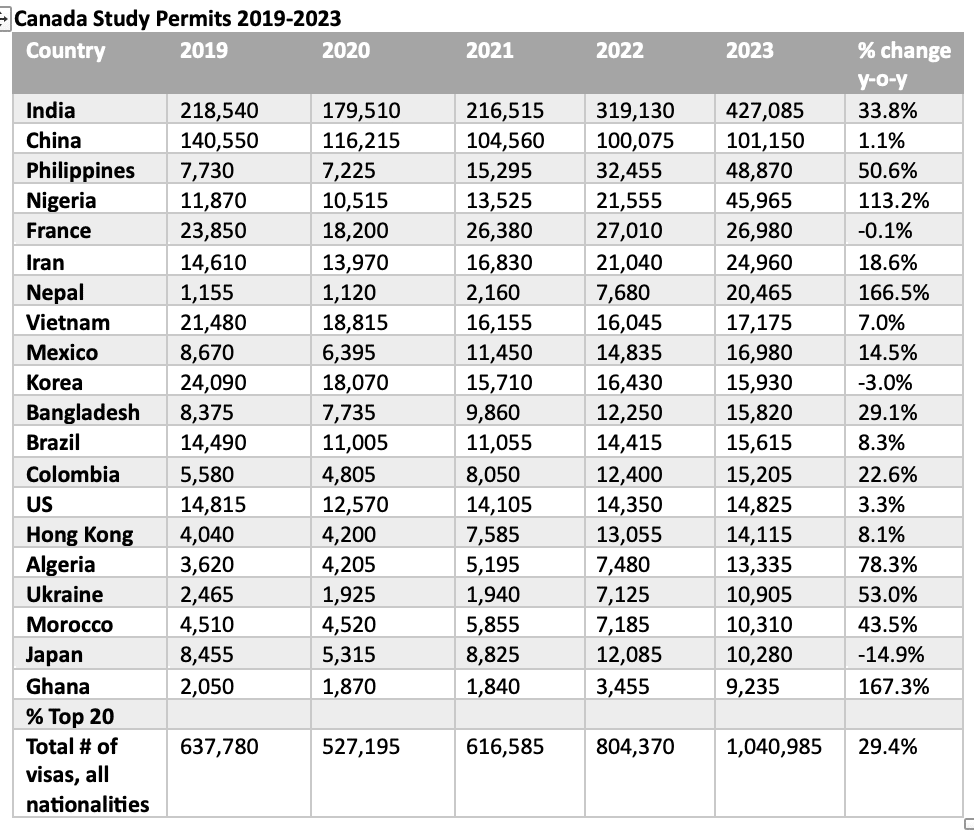Canada hosted more than 1 million international students in 2023
- Canada’s international student population soared to a record high in 2023
- More than a million students were enrolled in approved programmes of six months or longer, and most of those students were studying at a college or university
- The 27% y-o-y growth follows a 30% expansion in 2022
The number of international students with active study permits in Canada rose to 1,040,985 in 2023, a 29% increase over 2022, according to just-released data from Immigration, Citizenship and Refugees Canada (IRCC). Study permits are issued for programmes of at least six months’ duration, and most of those permits are held by post-secondary students enrolled in colleges and universities.
The new total:
- Is almost 10% higher than the 950,000 students the government had anticipated for 2023;
- Follows 30% growth in 2022;
- Means that Canadian institutions are currently hosting almost as many international students as US institutions are despite the US population being roughly nine times bigger than Canada’s.
Top sending countries
India and China continue to make up just over half the volume of international students in Canada, but as shown in the table below, there is notable growth from the #3 and #4 markets, Philippines and Nigeria. There has also been a near-tripling of Nepalese students over the span of one year alone, vaulting Nepal into Canada's Top 10 markets. Four African countries are in the Top 20, compared to one in 2018, and outside of the Top 20, there are major growth stories from other African countries. For example, there were 100% more Cameroonians (8,095), 88% more students from Côte d'Ivoire (6,530), 58% more Congolese (6,125), and 84% more Senegalese (5,580) in Canada in 2023 versus 2022.

In terms of diversification, Canadian institutions were overall as diversified in 2023 as 2022, with the Top 10 markets making up 71.6% of all enrolments.
How are international students distributed across Canada?
Ontario, Canada’s most populous province, has long held the largest volume of international students in Canada, and its share of students has grown. In 2021, it hosted 49% of the total, while in 2023, it accounted for 51%. Driving this growth is the popularity of Ontario college programmes among international students.
The second- and third-largest enrollers of students, British Columbia (BC) and Quebec, each lost share. BC moved from 21% in 2021 to 19.5% in 2023, while Quebec went from 14% down to 11.5%).
Here are enrolments for 2023 broken down by province:
- Ontario: 526,015
- British Columbia: 202,565
- Quebec: 117,925
- Alberta: 63,425
- Manitoba: 28,190
- Nova Scotia: 26,610
- Saskatchewan: 18,695
- New Brunswick: 16,030
- Newfoundland and Labrador: 7,430
- PEI: 5,355
The provincial breakdown is especially relevant right now. Institutions across the country are awaiting more details about the extent to which this week’s announcement of a two-year cap on new study permits will affect them. They have been told that (1) overall, the number of approved study permits will drop by 35% in 2024 compared with 2023, and (2) the cap will be allocated based on each province’s population.
This means that the recruiting landscape will change more drastically in some provinces than others. Canada’s population is distributed unevenly across regions. For example:
- Ontario: 15.8 million
- Quebec: 8.9 million
- BC: 5.6 million
- Alberta: 4.8 million
- Nova Scotia: 1.1 million
Why is Canada intent on decreasing the number of new international students?
Canada is experiencing record-high population growth. The number of Canadian residents was estimated at 40.5 million on 1 October 2023, representing annual growth of 3.2% – a rate not seen since the 1950s. The expansion is being driven by non-permanent residents – i.e., international students and foreign workers. For example:
- International students now represent 2.5% of all residents in the country – double the proportion they represented just five years ago. In Ontario, international students make an even higher proportion: 3.5% of the province’s population.
- Between 2021/22 and 2022/23, the number of non-permanent residents (students and temporary foreign workers) increased by 256% despite a 6% decrease in net migration.
The volume of new international students is contributing to a situation in which there is far more demand for affordable housing than supply. Canada’s healthcare system is also struggling to provide quality care for patients. A growing number of economists say that the government’s immigration targets are too high, and Nanos Research public opinion poll conducted in September 2023 found that 55% of Canadians would like to see their government accept fewer international students.
Strengthening the case for a more carefully managed approach to international student enrolment growth is research showing that as many as 1 in 5 study permit holders in Canada are not actually studying at the institutions to which they have been accepted. "An analysis by Statistics Canada in November found that around 19% of international students with study permits did not have a record of studying at college or university here," reported The Globe & Mail newspaper. "Most of the colleges on IRCC’s top ten list of schools with the highest potential non-compliance rates are privately run and in Ontario, catering heavily to students from India."
Comparing the destinations
Canada’s expansion of its international student population (+30% in 2022, +27% in 2023) has been happening much more quickly than leading competitors. For example:
- US (2022): 1,362,160 on F-1 or M-1 visas, a 10.1% year-over-year increase
- UK (2021/22): 679,970 in higher education, a 12.4% year-over-year increase
- Australia (2022): 619,370, an 8% year-over-year increase
It will be interesting to see whether more stringent visa policies in place this year in the UK and Australia constrain the growth of international enrolments in 2024. Real-time data already point to a softening flow of applications in the UK.
For additional background, please see:
















